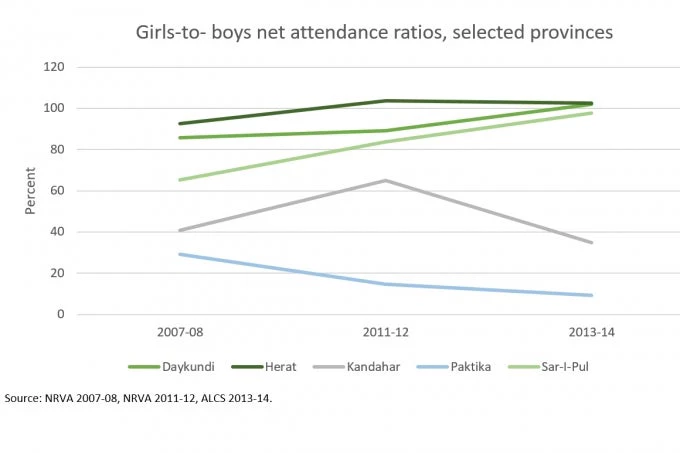
Afghanistan grapples with a range of challenges from growing insecurity to stagnating growth and rising levels of poverty. It is no surprise that the impact of the violent conflict on the country’s economic prospects and the welfare of its people is profound. Yet, Afghanistan carries ambitious development goals including achieving gender parity in primary schooling by 2030 among others. To ensure Afghanistan meets its goals, it is important to know how the country has progressed on socio-economic outcomes.
In collaboration with the Ministry of Economy of the Islamic Republic of Afghanistan and based on data provided by the Central Statistics Organization, the World Bank recently published the third edition of the Provincial Briefs (also available in Dari and Pashto), which provides a comprehensive profile of the most recent progress on a set of socio-economic indicators including education both at the national and at the provincial levels[1].
What do they reveal? We can see Afghanistan has achieved impressive improvements in human development outcomes—in areas such as education, health, and access to basic services. But this overall progress has not benefitted everyone equally and gaps in access between Afghans living in different provinces persist. In fact, where Afghan families live matters greatly for their socio-economic outcomes. And when it comes to schooling, this is no different. Location determines whether children will go to school or not.
The briefs show that girls face particularly stark challenges to attend primary school. But in instances where they go to school, the students seem to be happy and nurture a career goal. “There should be no difference between boys and girls. I am not afraid. I am happy to come to school. I want to be an engineer," said Masouda Nabi, a student of Daricha-e-Noor School in Kabul.
Unfortunately, not all girls have the opportunity to go to school as Masouda does. One can witness large differences in primary school attendance between girls and boys. In Afghanistan, the girls-to-boys attendance rates in primary school increased between 2007-08 and 2011-12 but fell between 2011-12 and 2013-14. On average, for every three Afghan boys, only two Afghan girls attended primary school in 2013-14. Even if Afghanistan had managed to maintain the same pace of progress between 2007-08 and 2013-14, it still would not have achieved gender equality in primary school attendance, leaving behind many girls.
The question then becomes where should we focus on investing in girls’ education to achieve gender equality? To answer this, data at the national-level alone wouldn’t be sufficient. We need to look at data from Afghanistan’s provinces to measure progress. The briefs show each province’s progress since 2007, allowing us to assess the likelihood of eliminating gender disparities in primary school attendance. Disturbingly, in the majority of provinces (18 out of 34), the progress we saw from 2007-08 to 2013-14 would not be sufficient to eliminate gender disparities in primary schooling by 2030.[2]
However, there are certain provinces that stand out and give us hope. In Daykundi and Herat, more girls than boys attended primary school in 2013-14. In addition, seven provinces will achieve gender equality in primary school education in the next five years given their current rate of progress. Sar-e-Pul province achieved tremendous progress from 2007-08 to 2013-14 in increasing the ratio of girls-to-boys primary school attendance. At this rate, Sar-e-Pul is on track to eliminate gender disparities in primary education within one year.

In other provinces, however, we observe a reversal of progress. In Kandahar, the girls-to-boys attendance ratio went from 41 percent in 2007-08 to 64 percent in 2011-12 but has declined to 35 percent in 2013-14. Paktika province has the lowest ratio in Afghanistan at 9 percent in 2013-14.
Targeted investments and institutional support for the education of children–particularly girls–are necessary to ensure children have the opportunity to attend school no matter where they live. The ratio of girls-to-boys attending school is falling, as a result of conflict. Conflict reduces incentives for families to send their children to school—this is particularly the case for girls as returns to education are lower than for boys. This will have long lasting consequences and educating children, particularly girls, in conflict-affected areas should be a primary concern of policy makers



Join the Conversation